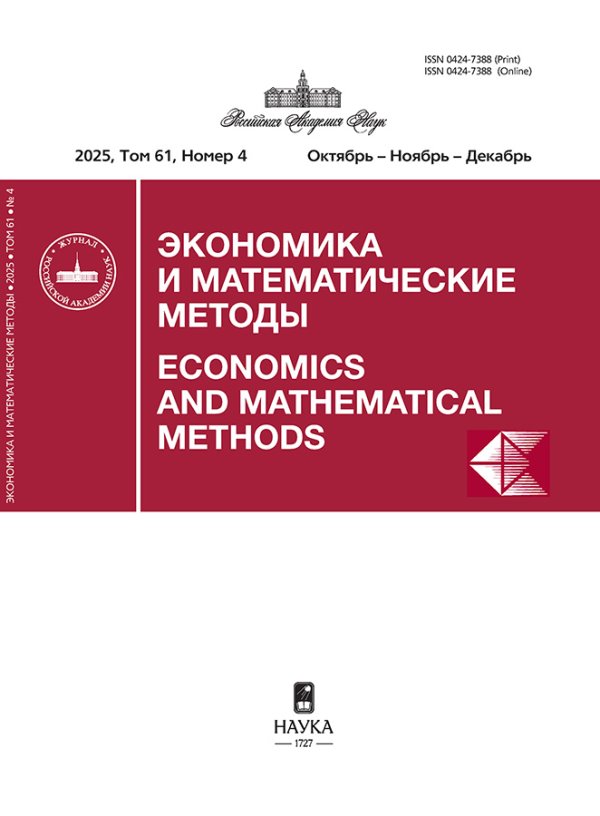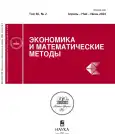Парадокс капиталоемкости
- Авторы: Дементьев В.Е.1
-
Учреждения:
- ЦЭМИ РАН
- Выпуск: Том 60, № 2 (2024)
- Страницы: 27-39
- Раздел: Теоретические и методологические проблемы
- URL: https://gynecology.orscience.ru/0424-7388/article/view/653299
- DOI: https://doi.org/10.31857/S0424738824020037
- ID: 653299
Цитировать
Полный текст
Аннотация
Снижение капиталоемкости производства позволяет поддерживать экономический рост при низкой норме накопления капитала. Однако связь между развитием экономики знаний и динамикой капиталоемкости имеет сложный характер. В отдельные периоды времени она положительная, в другие — отрицательная. Допустимо рассуждать о существовании парадокса капиталоемкости по аналогии с парадоксом производительности (парадокс Солоу). Для выявления того, как может формироваться парадокс капиталоемкости, в статье строится математическая модель обновления технологической базы производства. Особенностью модели является как ее многофазный характер, так и разграничение инвестиций в текущее производство, фундаментальные исследования и прикладные разработки. При описании сферы фундаментальных исследований и сферы производства используются логистические функции. Они позволяют учесть существование положительного эффекта масштаба в этих сферах и то, что он сохраняется лишь до некоторого объема используемых ресурсов. В модели представлено не только чередование длинных волны технологического развития, но и наложение волн друг на друга. Важное свойство этой модели состоит в том, что смена фаз развития основывается на определенной экономической логике, а не задается экзогенно. Выполнен иллюстративный расчет по модели, в результате которого получена траектория изменения капиталоемкости производства. Конфигурация этой траектории близка к тому, как реально менялась капиталоемкость производства в экономике США в период 1960–2022 гг. Предложенная модель демонстрирует связь парадокса капиталоемкости с периодическим обновлением технологий широкого назначения, с порождаемыми этими обновлениями волнами Кондратьева.
Полный текст
Об авторах
В. Е. Дементьев
ЦЭМИ РАН
Автор, ответственный за переписку.
Email: vedementev@rambler.ru
чл.- корр. РАН
Россия, МоскваСписок литературы
- Аганбегян Г. А. (2023). Инновации в России: от высокого знания и наличия перспективных научных заделов к эффективному социально-экономическому развитию // Экономическое возрождение России. № 2. С. 13–26. doi: 10.37930/1990-9780-2023-2(76)-13-26 [Aganbegyan A. G. (2023). Innovations in Russia: From possessing the higher knowledge and promising scientific groundwork towards effective socio-economic development. Economic Revival of Russia, 2, 13–26. doi: 10.37930/1990-9780-2023-2(76)-13-26 (in Russian).]
- Андрукович П. Ф. (2023). Модели длинных волн Н. Д. Кондратьева для трех крупных стран Европы // Экономическая наука современной России. № 3. C. 47–66. doi: 10.33293/1609-1442-2023-3(102)-47-66 [Andrukovich P. F. (2023). Kondratiev N. D. long wave models for three large European countries. Economics of Contemporary Russia, 3, 47–66. doi: 10.33293/1609-1442-2023-3(102)-47-66 (in Russian).]
- Глазьев С. Ю. (1993). Теория долгосрочного технико-экономического развития. М.: ВлаДар. [Glazyev S.Yu. (1993). Theory of long-term technical and economic development. Moscow: Vladar (in Russian).]
- Дементьев В. Е. (2021). Модель интерференции длинных волн экономического развития // Компьютерные исследования и моделирование. Т. 13. Вып. 3. C. 649–663. [Dementiev V. E. (2021). The model of interference of long waves of economic development. Compute Research and Modeling, 13, 3, 649–663 (in Russian).]
- Дементьев В. Е. (2023). Обновление технологической базы экономики и реальные процентные ставки // Журнал Новой экономической ассоциации. № 3 (60). С. 104–119. doi: 10.31737/22212264_2023_3_104-119, EDN: LBKSGQ [Dementiev V. E. (2023). Updating the technological base of the economy and real interest rates. Journal of the New Economic Association, 3 (60), 104–119. doi: 10.31737/22212264_2023_3_104-119, EDN: LBKSGQ (in Russian).]
- Лавровский Б. Л., Чуваев А. В. (2022). О соотношении экономической динамики и нормы накопления: международный опыт // Проблемы прогнозирования. № 2 (191). С. 6–16. doi: 10.47711/0868-6351-191-6-16 [Lavrovskii B. L., Chuvaev A. V. (2022). On the relationship of economic dynamics and accumulation rate: International experience. Studies on Russian Economic Development, 2 (191), 6–16 (in Russian); 33, 2, 127–134. doi: 10.1134/S1075700722020071 (in English).]
- Маевский В. И., Рубинштейн А.А. (2023). Волны Кондратьева и современная макроэкономика // Научные труды Вольного экономического общества России. № 2. С. 87–110. doi: 10.38197/2072-2060-2023-240-2-87-110 [Maevsky V. I., Rubinstein A. A. (2023). Kondratieff waves and modern macroeconomics. Scientific Works of the Free Economic Society of Russia, 2, 87–110. doi: 10.38197/2072-2060-2023-240-2-87-110 (in Russian).]
- Acemoglu D., Autor D., Dorn D., Hanson G. H., Price B. (2014). Return of the Solow paradox? IT, productivity, and employment in US manufacturing. American Economic Review, 104 (5), 394–399.
- Aghion P., Antonin C., Bunel S., Jaravel X. (2022). The effects of automation on labor demand: A survey of the recent literature. In: Robots and AI: A new economic era. L. Y. Ing, G. M. Grossman (eds.). N.Y.: Routledge, 15–39. doi: 10.4324/9781003275534-2
- Bas J., Nahuis R. (2002). A general purpose technology explains the Solow paradox and wage inequality. Economics Letters, 74, 2, 243–250.
- Brynjolfsson E., Rock D., Syverson C. (2019). Artificial intelligence and the modern productivity paradox: A clash of expectations and statistics. In: The economics of artificial intelligence: an agenda. Agrawal A., Cans J., Goldfarb A. (eds.). Chicago: University of Chicago Press, 23–60.
- Capello R., Lenzi C. (2022). Giovanni Perucca the modern Solow paradox. In search for explanations. Structural Change and Economic Dynamics, 63, 66–180. doi: 10.1016/j.strueco.2022.09.013
- Capital productivity (1996). McKinsey Global Institute. Washington. Available at: https://www.mckinsey.com/capabilities/operations/our-insights/capital-productivity
- Derkacz A. J. (2020). Capital intensity of investments and GDP dynamics. SSRN Electronic Journal. doi: 10.2139/ssrn.3639572
- Helpman E., Trajtenberg M. (1994). A time to sow and a time to reap: Growth based on general purpose technologies. National Bureau of Economic Research, Working paper 4854. doi: 10.3386/w4854
- Ing L. Y., Grossman G. M. (eds.). (2022). Robots and AI: A new economic era. 1st ed. N.Y.: Routledge. doi: 10.4324/9781003275534
- Kalecki M. (1954). Theory of economic dynamics. An essay on cyclical and long-run changes in capitalist economy. London: Allen & Unwin Ltd. 178 p.
- Solow R. M. (1987). We’d better watch out. New York Times Book Review, 36.
Дополнительные файлы












